Click here for last week's episode.




My dog loves belly rubs. I do, too, but I rarely get one even when I roll over into an appropriate position. Even from strangers my dog is more likely to get belly rubs than I am. I try not to be jealous.
But not all animals like belly rubs. Cats, for example, will likely bite you if you try (note: I will not bite you). Different animals like different types of physical contact. Adam Ellis of BuzzFeed has helpfully rounded up 15 charts illustrating how animals typically feel about you touching particular body parts. You can view them all here.

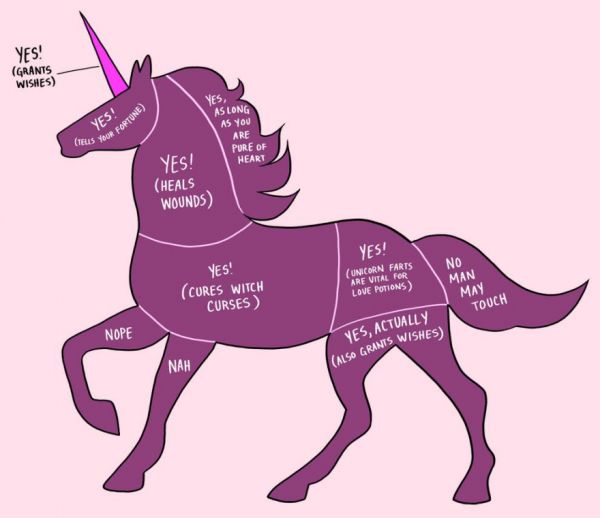
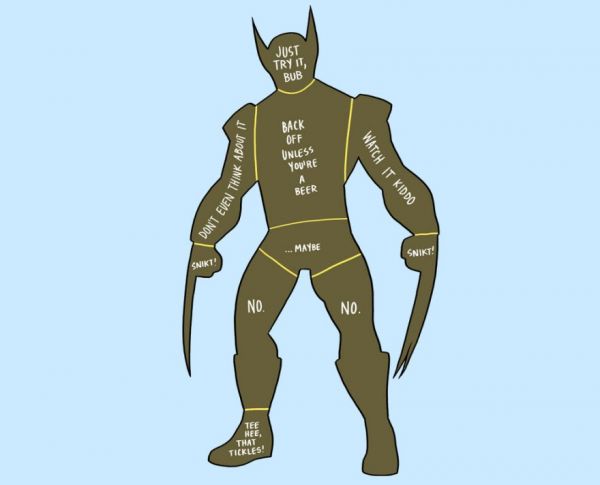
-via 22 Words
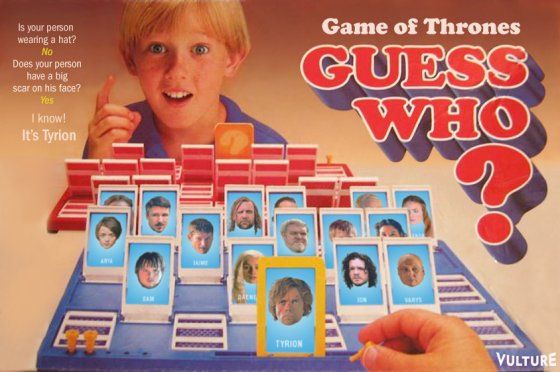
Guess Who? is a kids' board game played by two people. Each player has 24 cards with faces on them. The players take turns asking each other questions about the identity of one designated face card among the 24. The person who guesses his/her opponent's designated card first wins.
Vulture has created a downloadable variant of the game for Game of Thrones. You can find it here.

It would really come in handy, since there are so many characters in the series that it's hard for them to keep even themselves straight. You can ask questions like, "Have you had an important body part cut off?" and "Hodor?" and "Are you obsessed with vengeance?"
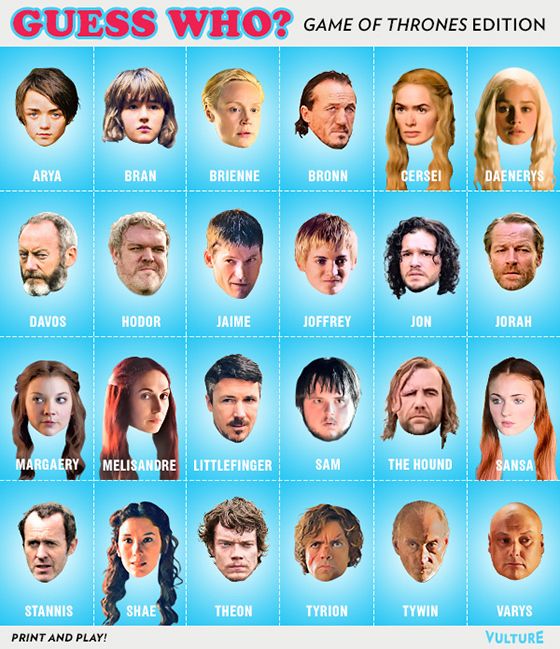
-via Nerd Approved
En una sociedad en la que la igualdad de sexos y la lucha por los derechos de gays y lesbianas desgraciadamente siguen siendo temas de candente actualidad y eterna discusión, la transexualidad resulta un asunto tabú para la inmensa mayoría. Ni está bien visto, ni se toma demasiado en serio, cuando es algo que va más allá del acto de un hombre vistiendo con ropa de mujer y viceversa.
Hace unos días me llamó mucho la atención esta fotografía, perteneciente al proyecto The Machine To Be Another a cargo de BeAnotherLab, y del comentario que la acompañaba, que venía a decir lo siguiente:
“El sentido del individuo está vinculado a nuestros cuerpos, para bien o para mal, pero nuestras identidades no siempre coinciden; una persona gorda siente que hay un ser delgado en su interior esperando ser liberado. Para la gente con disforia de género la naturaleza les ha jugado una mala pasada. La máquina de ser otro nos da una idea de que es sentirse dentro del cuerpo de otro”.
Esto me hizo reflexionar. Hasta los 20 años era una chica bastante delgada, pero un día mi metabolismo cambió, y aunque ya han pasado unos cuantos años de ello, nunca he terminado de asimilarlo. Siempre me imagino delgada y cuando tengo que afrontar que no lo estoy me jode. Si yo, que peso unos kilos de más, ya me siento incómoda conmigo misma en algunas ocasiones, cómo debe sentirse una mujer en el cuerpo de un hombre?
Por esta razón, y ejemplificado en un personaje público, al menos dentro del ámbito del rock, me gustaría hablar del caso de Laura Jane Grace, alma y líder del grupo Against Me!, que en mayo de 2012 dejó a la parroquia rockera boquiabierta al hacer pública condición de mujer. Así, dejaba de ser Tom Gabel para convertirse en Laura Jane Grace, mediante el habitual proceso hormonal, para terminar con una reasignación de sexo completa cuando esté psicológicamente preparada.
Cualquiera puede remarcar que muchas personas llevan a cabo esta transformación sin hacerlo público, y tienen razón, pero no todo el mundo tiene un perfil como el de la cantante, ni una situación sentimental tan particular como la suya: casado y con una niña.
Sin duda, la decisión de romper con todo para ser ella misma debió de ser sumamente difícil, a sabiendas de que muchos le darían la espalda y que podría perder a su propia familia, pero no quiero imaginar el sufrimiento y frustración de Tom padeciendo disforia de género.
La Disforia de género no es algo tan sencillo como sentirse cómodo llevando ropa de mujer, como le sucedía al director de cine Ed Wood, que se volvía loco con la angora. Hablamos de sentir y pensar como una mujer, de tener un cuerpo con el que uno no se identifica, y de tener que reprimir la propia naturaleza por miedo a la incomprensión, rechazo y marginación. Imposible no padecer ningún trastorno o secuela llevando tal carga a las espaldas.
En el caso de Gabel, que confiesa que desde muy pequeño tomó a Madonna como su musa y ejemplo a seguir, y traumatizado además por el divorcio de sus padres, su adolescencia no fue precisamente un paseo por la pradera. El abuso de alcohol y drogas, acompañado de un contante estado de depresión, la crueldad de algunos compañeros que lo marginaban e incluso le pegaban por ser “maricón” y su aversión hacia el sistema establecido marcaron los años claves en los que la personalidad y el carácter del individuo se forjan, convirtiendo al niño en un adulto. Fue a los 17 años, cuando este joven rebelde dejó el instituto, se largó a Gainesville en Florida, y empezó a traducir su odio y su confusión en composiciones musicales, dando lugar a su proyecto Against Me! Un nombre que, analizando la trayectoria de Laura Jane Grace, adquiere un tremendo sentido.
La artista se ha liberado, y lo ha gritado a los cuatro vientos. Es más, actualmente está involucrada en proyecto televisivo en el que trata la transexualidad de gente de la calle. Estoy segura que su testimonio podrá ayudar a muchas personas que se encuentran en una situación confusa, y hará ver a muchos que la disforia de género no es un virus, ni una enfermedad, sino más bien, como decía el pie de foto, una fatalidad del destino, pero que puede ser reconducida, al menos para permitir al afectado no sentirse miserable ni culpable por ello.
Hace unos días leí un par de entrevistas muy interesantes que le hicieron, primero para Cosmopolitan un año después de su anuncio, y otra publicada en la revista RockZone en su número de abril, que volvieron a invitarme a la reflexión.
¿Cómo debe de sentirse una mujer que ha sido físicamente un hombre hasta los 30 años? ¿Se sentirá femenina plenamente? Ser mujer no es fácil, lo sabemos. Ser hombre intuimos que tampoco, pero nunca nos hemos metido en su piel. Para mí ser mujer tiene cosas buenas y cosas malas, y otras que son exclusivas de nuestro género. Laura Jane Grace nunca gestará a su propio hijo, y posiblemente yo tampoco. Ese es un ejemplo demasiado típico. Pero ¿será el crecimiento de sus pechos a través de sus tratamientos hormonales comparable a nuestra pubertad? Nunca tendrá la regla, ni sufrirá la montaña rusa emocional de los síndromes premenstruales, y tampoco padecerá los clásicos sofocos de la menopausia. Cuando sea mayor ¿tendrá achaques de hombre o de mujer?
Si tuviese la oportunidad de hacerle una sola pregunta, me gustaría que me explicara qué es para ella lo mejor y lo peor de ser mujer. Estoy segura de que su respuesta sería sorprendente y haría valorase más mi propia condición e identidad.

Claro que se puede querer a dos personas a la vez, pero una de ellas tienes que ser tú.
By Oneinmany
Queréos tías, y no solo en plan sexual que también, que gente que os odie nunca os va a faltar. ^^
¿Os acordáis de Golpe en la Pequeña China, aquella extraña película ochentera de John Carpenter sobre un camionero que se metía en un lío que iba complicándose poco a poco hasta tomar forma de película de Kung-Fu con tintes sobrenaturales? No fue un film de éxito masivo pero ha dejado huella en un montón de espectadores. ¿Créeis que ya es el momento adecuado para un remake o una secuela? Tranquilos, de momento nadie tiene previsto mancillar vuestros recuerdos profanando esta película. Al menos en el cine. Porque de lo que os queremos hablar es de Golpe en la Pequeña China, EL CÓMIC.
Boom Studios se ha hecho con los derechos de explotación de esta película para un cómic que será realizado por Eric Powell y Brian Churilla. Así pues, podremos leer nuevas aventuras de Jack Burton, el personaje que interpretó a la perfección Kurt Russell.
El 4 de junio se pone a la venta en Usalandia el número uno de BIG TROUBLE IN LITTLE CHINA, con una portada ilustrada por Eric Powell y una edición limitada con varias portadas alternativas, dibujadas por Joe Quinones, Chris Weston y Terry Dodson.
El argumento de la nueva aventura de Jack nos muestra cómo este camionero se encuentra con una fuerza demoníaca que se manifiesta en la boda de su mejor amigo Wang.
The post Vuelve Golpe en la Pequeña China appeared first on Teenage Thunder.

Painting by Kunisada Surimono. Image courtesy of Wikipedia Commons
If you aren’t masturbating right now, you should be. May is International Masturbation Month, which means if you have been celebrating properly, you should have carpal tunnel and a very sticky laptop. If you haven’t, you should clear your weekend plans for some five-knuckle shuffle.
Good Vibrations, a sex toy shop in San Francisco, declared May 7, 1995 to be the first National Masturbation Day, after President Bill Clinton fired Surgeon General Joycelyn Elders because she suggested that masturbation be included in sex education as a way to combat the spread of AIDS. Obviously, one day was not enough to dedicate to the practice of self-love, so the entire month was soon devoted to rubbing one out.
Since I think everyone should take advantage of their right to masturbate all month long, I have rounded up the best masturbatory tools for your pleasure. It’s time for you to spend some quality time with you.
Fresh Brew Love Skin® Masturbator Vagina

Want to masturbate discreetly on your morning commute or during a boring meeting? You can do it with this masturbator that is disguised as a coffee cup. No one will even notice you're dunking your dick in the java like a jelly doughnut. Buy it here for $11.
XM Midi Ring Vibrator

This is the only ring that matters during Masturbation Month. It will give you more pleasure than a bulky carbon stone any day. All your friends will be jealous. Buy it here for $74.95.
Keith Haring Tenga

Tenga makes your dick feel like it’s been sucked up by a vacuum cleaner—in a good way. This one is extra special because it was designed by Keith Haring, so you can keep it around for decoration or regift when you’re finished. Buy it here for $9.99.
Lovelife Smile Discreet Vibrator

All women need this Smile vibrator in their life. It knows you better than you know yourself. It has adjustable speeds and fits in your pocket. I think God created it. Buy it here for $59.
Bordello Saskia

Who doesn’t want to fuck a lady piledriver-style? Plus the description says she is an educated conversationalist who loves to laugh. Clearly this fine little lady will keep you entertained for hours and won’t complain about cramping up. Buy it here for $118.
Cheeky Pets Three Speed Vibe

This is for all the animal lovers out there. This three-speed vibrator comes in various shapes such as bear, alligator, and walrus. If you ever had the urge to shove a cute creature into your vagina, here is your chance. You can even cuddle it when you’re done. Buy it here for $28.82.
"Getting Off: A Woman's Guide to Masturbation"

A little reading material between petting the pussy will help you have an even better orgasm the next go-round. Buy it here for $15.95.
Realistic Tongue Vibrator

I was drawn to this product because it’s shaped like a tongue, but after further observation, the color makes it look like it belongs to Gollum. I think some chicks dig that, so I am keeping it on the list. Buy it here for $14.39.
Lonely and Lusty Inflatable Love Doll

Masturbation Month is a time to embrace being lonely and lusty. This love doll has a ribbed love tunnel and a deep throat. Just look at that face. You might have to call off of work for this one. Buy it here for $86.01.
Penthouse® Secrets Bath Bliss

This kit is all about relaxing and romancing. Light a candle, blow up the bath pillow, and give yourself the best orgasm of your life with the multi-speed massager. Buy it here for $29.99.
Misty Stone Butt Fleshlight

This is an exact replica of Misty’s gorgeous booty hole. If you are looking to get some backdoor action, this is the obvious way to go. Just close your eyes and you'll really feel like you're inside of her large intestine. Buy it here for $59.96.
Animal Delight Dual Rotating Vibe

This new product also incorporates animal buddies into your orgasms. This time they just vibe on your girly parts as a cute little reminder they’re there. Buy it here for $69.99.
I hope you have a great time playing with yourself. Happy Masturbation Month!
Follow Erica Euse on Twitter.

Photo courtesy of Wikimedia Commons
Sex seems to be the only part of the pregnancy and birth process that all mothers endorse.* Sure, there are some glowing ladies in muumuus who seem to breeze through pregnancy, while others swell and vomit and grow full lady-beards, and others who claim the whole endeavor was “like, so natural, I just had to let it happen,” but for the most part, the process of giving birth is, as a friend and new mother recently told me, “no fucking joke.”
I have to imagine she is correct. In the best case scenario, childbirth is about a full day of sweating, dilating, pushing, shitting, and leaking fluids. BEST CASE. Sure, you end up with a baby you love and plan to raise into the first woman president to invent an eco-friendly cure for cancer, and your body really jacks itself up on cozy love hormones to help you forget what just happened, but there’s no way around it: Giving birth is hard.
By the way, have you called your mother yet today?
I'm going to leave that passive-aggressively hanging in the air, true mom-style, and plunge right into a full description of how all of us ungrateful little turds came to be.
First things first: Childbirth is beautiful and amazing. Of course it is. It’s also messy, gooey, farty, bloody, incredibly painful, and literally shitty. I’m not trying to knock the beauty of childbirth here. My friend gave birth to her daughter who was, she said, “literally covered in both her own shit and mine,” and my friend and her husband agreed that it was the most beautiful thing either of them had ever seen. I believe them. I also believe that pushing that hard would let out a world of sounds, gases, fluids, and solids that would make the whole process a straight up nightmare. A beautiful one, I guess.
If you’ve never been present at a birth, there is a truly unbelievable number of videos on YouTube of women squatting in paddling pools and lying in hospital beds, shitting and pushing and birthing for all the world to see. It’s fascinating, inspiring, and vaguely horrifying.
Early labor lasts between eight and 12 hours (!), and involves 30 to 45 second contractions that are roughly five to 30 minutes apart. These start slow, but get progressively more intense—think period cramps on steroids. At some point mom’s water breaks. While this sometimes happens as a massive Hollywood-style gush, many moms describe a “pop” (okay), followed by a “gush” (uh-huh), and then a “bunch of leaking” (oh no). Again, we're talking about the best case scenario. If it doesn’t break on its own, here’s what happens according to the Mayo Clinic (emphasis and profanity mine):
If your health care provider believes the amniotic sac should be opened during active labor—when your cervix is at least partially dilated and the baby's head is deep in your pelvis—he or she might use a technique known as an amniotomy to rupture the membranes. During the amniotomy, a thin plastic hook [fuuuuuuuuuuuuuuuuck] is used to make a small opening in the amniotic sac. The procedure might cause some discomfort.
I’d imagine it might.
After the water has broken and contractions are coming harder, better, faster, and stronger, it’s time to go to wherever it is mom is planning on giving birth. Whether this is a hospital, birthing center, pool in your living room, or a nest dad made out of cushions and sheets, mom needs to get there. Advice on birth and caring for someone who is giving birth involves a LOT of parenthetical caveats, like “Focus on something other than the pain (this may be hard to do),” “Try to distract her from the contractions with a simple card game or massage (don’t think there is something wrong if she is not responding to you),” and “Don’t tell her that something is wrong if she seems to be angry (it’s a normal part of transition).”
At this point a lot of strangers’ hands have been inside mom’s vagina. The strangers are professional doctors, nurses, doulas, and/or midwives, but I’m sure the situation is still uncomfortable. They are prodding up in there with their cold, gloved fingers, like mom’s a Thanksgiving turkey, checking to see how dilated her cervix is. (The cervix is normally a tiny slit, barely open at all. By the time your giant infant head is ready to burst out of there and into the world, it will be about ten centimeters, which is, as one website helpfully notes, about the circumference of a large bagel.)
Now we move to the second stage. (Information brought to you by the UK’s National Institute for Health and Care Excellence, whose acronym, NICE, has never been more ironic than during this description of the pushing stage.) This is the one you see on TV shows that includes breathing, screaming, and legs in stirrups. It is not always like that (see: this clip of Kourtney Kardashian calmly yanking her baby out of herself), but it does not sound fun. During this phase, according to Americanpregnancy.org, mom is likely experiencing strong urges to push, intense pressure at the rectum, burning, stinging, and a likely bowel or urination accident. According to one mother, “No one cares [if you poop during the second stage]. You don’t care. They don’t care. You shit and keep going.”
Eventually you start crowning, a process which, for mom’s vag, involves something Americanpregnancy.org calls “the ring of fire”—an intense burning and stinging from the stretching of the vaginal walls by your big stupid head. But don’t worry! This feeling of burning is closely followed by a feeling of numbness, which “comes from the baby’s head stretching the vaginal tissue so thin that the vaginal nerves are blocked,” and remember, “There is no set time frame for how long this step of delivery will last.” But wait, there’s more: There’s an entire NICE subsection regarding this phase of Perineal Trauma. The description led me to wince, cross my legs, and scream, “Oh no!” to myself.
More pushing, more tearing, possibly more shitting, and then you’re born. Congrats, you did nothing. You fed off your mom’s food and bodily fluids for nine months and then you got into the appropriate position to rip her bottom half open so you could enter the world. And you don’t even look great, so she can’t instagram you. Newborn babies have cone-shaped heads, puffy eyes, a fine coating of lanugo (downy hair), and vernix (which Americanpregnancy.org calls a “cheesy substance that coats the fetus in the uterus”), plus enlarged genitals for some reason. Gross.
And even after you’re safely out of there, all gooey and hairy and loud, there are still a ton of horrible things happening to your mom’s long-suffering nether regions. There’s an entire “third birth stage” that doesn’t even START until you’re born. This third stage involves the passing of the placenta, also known as “afterbirth.” I don’t know how to break this to you, but at this point things are so wrecked down there, it takes another round of contractions and a few pushes for the placenta to gush out of the vagina like a bloody, amniotic waterfall.
After all of that is finally over and everyone is cleaned up, stitched up, and dried off, your mom has to hang around having her underbutt area monitored for excessive bleeding. Birth is some Paul Thomas Anderson shit: There Will Be Blood.
This tale is, again, an ideal birth scenario. It does not include complications like the baby being in breach or umbilical cords wrapped around places they shouldn’t be, let alone any toilet labor scenarios as seen on I Didn’t Know I Was Pregnant. It truly is no fucking joke.
So let me ask you this: When you say you love someone, do you mean, “I would risk perineal trauma for you?” Do you mean, “I would let someone turn the area between my butt and vagina into some kind of kitchen and solarium extension project for you?” Do you mean, “I would have sex with your dad, your gross old dad, to give you, specifically, a chance to try it out in this big, crazy world?”
I didn’t think so.
I know there are lots of ways to express love, and that the physical trauma and emotional slog of childbirth don’t guarantee that you’ll feel loved by your mother, or even that she'll continue to demonstrate or feel love for you. But holy hell, it’s a pretty big ordeal to go through together right off the bat. She doesn’t even know you yet! You can grow up to be vegan, get a Chinese symbol tattoo, or like Mumford and Sons. Maybe you will! And sure, the two of you might not jive, but that doesn’t take away what happens the day you are born, when her body gets all messed up and she pushes and screams and shits in front of people so you can be alive. I’m saying motherhood is complicated.
If you can, hug your mom today. Or call her! Call her and say, “I love you, mom. Sorry about your perineum.”
*If you are one of those people who gets grossed out by the idea of your mom having sex, you need to shut up. The woman who MADE YOU VIA SEX isn’t allowed a healthy, active sex life? She did it that one time so you could be here, and you’re allowed to bang whoever you want, but the woman whose cells formed the first inklings of your penis or vagina should be cloistered? Nope. Nu-uh. You don’t have to want to be there. You don’t have to want to hear about it. But you do have to hope your mom is getting it hard** and on the regular.
**Assuming hard is how she likes it. I don’t know your mom.
Follow Monica Heisey on Twitter.

Photos by Justin Morrison and Kelly O
I've watched a lot of weird porn, because stereotypical porn about fake blondes with fake boobs bouncing on a greasy dude’s dick is meh to me. I have no desire to watch a cartoon pound E.T. in the ass while yelling, “Shut up and take it, space whore!” (E.T. 2: Dark Territory) or watch porn in a public theater—what sex columnist and It Gets Better Project founder Dan Savage described as “seeing porn the old-fashioned way,” when he spoke to me over the phone a few weeks ago.
Since 2005 Savage has organized the HUMP! Film Festival. Every year regular people become porn stars for a weekend, filming their own five-minute sex tapes that they show at the festival, where they compete for cash prizes. This year Savage has taken 20 of the short films on tour across America. A few weeks ago, I attended the New York stop of the HUMP! Tour to pop my porn-theatre cherry.

Before the event I wondered if the theater's ushers would pass through the aisles to check if anyone was masturbating. As Chie, a young Canadian woman in attendance, put it, “This is definitely my first time doing anything like this. I've watched lesbian porn at home, sure, but nothing this wild and not with this many people around.” Chances are some of the amateur porn stars had never watched porn in a theater either. “We got submissions from teachers, doctors, lawyers, bus drivers, and baristas who want to show off, have fun, and get their freak on,” Savage told me.
Some of their movies were more silly than sexy. The mocumentary Mythical Proportions explored the taboo of centaur sex, while other films were straight up sexy. Magic Love showed a straight, good-looking couple fucking in various places, including a bubble bath filled with packing peanuts—at one point he flung a peanut off his penis, and she caught it in her mouth.

The crowd favorites were tapes that were both hardcore and humorous. In The Beat a hot, young guy masturbated intensely with various anal toys. He delivered the perfect pop shot, and then the music changed, and we saw him picking up a bible and dressing in a sweater vest adorned with a nametag that revealed he’s a Mormon.
Tim, another audience member, told me his favorite aspect of the festival was that “the films were both sexy and funny, which is hard to achieve—it's usually one or the other.” This is what Savage was going for. “The films were meant to be both sexy and funny, which is how sex really is,” he explained. I told Dan I thought the film that won Best in Show last year, Ouroboros, was both explicit and romantic. The gay sex scene was so hot Rick Santorum would get hard watching it, yet for every explicit moment or funny joke, there was an intimate moment that balanced the scale, allowing hearts to warm as well as genitals.
Best of all, the festival taught straight dudes to get down with realistic gay and lesbian porn. One guy, Ben, saw gay porn for the first time at the festival. Krutch taught the audience about realistic lesbian sex and to remember that disabled people have fully functioning private parts. Described as proof “that people with disabilities have [genitals] that work just fine,” the movie cut back and forth between the disabled protagonist walking through New York City, dealing with public transportation, and masturbating at home in her leopard-print sheets. At the end of the film, her girlfriend walked in to join her, finding her face flushed with post-orgasm sweat. (Porn can be romantic!)

Other movies introduced the audience to new sex techniques. Edged taught the audience about edging (bringing someone to the brink of an orgasm then not allowing them to come), when the sub character unsuccessfully prevented her orgasm by thinking about tampon commercials and Sarah Palin.
One of my favorite shorts was Lauren Likes Candy, an S&M piece set against a chain-link fence. The film featured a Janet Jackson-style nipple clamp removal that made the audience gasp. The film balanced the extreme content with the ending, when the characters lay on the floor laughing—of course, there weren’t many lesbian-oriented movies. My one problem with the festival was the lack of trans, queer, and lesbian porn.
“That was a hurdle in putting the fest together,” Savage said, defending the event. “We don't keep any copies of the films or paperwork after the fest is over, so when we decided to take it back on the road, we had to from memory reach out to filmmakers. Not everyone we contacted wanted their film on tour. They felt comfortable with it in Seattle and Portland, but not in their home city.” He said the movies’ gender variance depended on what films people submitted.
“Three or four years ago, we had absolutely no lesbian films at all, which was a bummer for us, but then the next year, we were overwhelmed with lesbian submissions!” Savage said. “HUMP! is generated by its audiences. If there is something you want to see, make it!”
Savage had a point: HUMP! only reflects the turn-ons and politics of the participants. This structure has its flaws because it leaves certain groups out some years, but it also allows attendees to feel (some what) comfortable while learning they're turned on by porn they would never watch at home. How else would straight dudes know that realistic lesbian sex is hot?
For upcoming dates of the HUMP! Tour click here.
Follow Sophie Saint Thomas on Twitter.
SnobMoito cartiño levo deixado eu en Soundflat! <3
Nos visita el pinchadiscos alemán Marco Traxel, capo de la discográfica Soundflat. En su maleta trae unos cuantos adelantos de sus próximos lanzamientos, las referencias más recientes de su sello y una selección de singles habituales en sus sesiones de DJ. Playlist; Cavemen V (Ive been waiting), Los Retrovisores (Comprensión), Mystic Brew (Dont you want to stay), Electric Mess (Shes got something to say), Les Kischenettes (Jai L air de quoi), King Salami and the Cumberland 3 (Shes a Kukamunga), Gentlemens Agreements (All good thing), Shakers (Hold me baby), Las Aspiradoras (Atolón), Zu Zu Blues Band (Zu zu man), Troy Dodds (The real thing), Curtis Lee (Is she in your town), Omens (Searching), The Searchers (Umbrella man) y The Headhunters (Times we share).
I recently interviewed Sasha Grey for the cover of Nero Homme magazine–dream interview, yay! We chatted about porn, childhood, writing, provocation… and being bad Catholic girls ;)
Everyone knows Sasha Grey: she’s the pornstar who changed the game. A quick-witted, sexual provocateur, Grey entered the business in 2007 at age 18, and quickly spearheaded a shift in the mainstream’s view of the porno starlet from hapless victim to sexual heroine. Her first ever scene was a twelve-person orgy, during which she famously asked Rocco Siffredi–the notoriously rough “Italian Stallion”–to punch her in the stomach. Her porn career would go on to be defined by the extreme nature of her performances as well as her outspoken, intellectual approach to her job–the latter of which resulted in her often being called “the intellectual porn star.”
After leaving the business at 21, Grey went on to transcend the standard limitations of pornography when she was courted by Hollywood, playing the lead in Steven Soderbergh’s The Girlfriend Experience, as well as a semi-fictionalized version of herself HBO’s Entourage, among others roles. In 2011, she released a book of photography, titled “Neü Sex,” that consisted mainly of racy self-portraits. Now 25, Grey recently added ‘author’ to her list of achievements, with the release of The Juliette Society, a satirical, erotic novel that follows Catherine, a film student who enters a secret, elite sex society.
You are obviously a very creative person–you perform, you act, you write, you make music, you take photographs. Back when you were still doing porn, did you see it as a creative outlet?
Grey: Oh, absolutely. Porn was my art. I poured my heart and soul into it, and that’s a very controversial thing, because a lot of people just want porn to be porn. But that was something I was always very outspoken about. And ya know what… I’ve been traveling all over the world this part year and a half, and meeting fans, and it’s been great to find that the things that I was outspoken about and stood up for back when I was doing porn still resonate with people. And as I continue to grow and do other things with my life, I can only hope that my new projects have the same power, and resonate with the people in the way my porn performances did.
You’re someone who instigated a change in the mainstream’s perception of women in the porn industry, and pioneered a new wave of intelligent, sex-positive, feminist porn stars. Now that you’ve been away from porn for a while, do you look back and feel happy with the progression the business has made?
Well, I definitely see a difference. You know, even when I was in the business, other women like Bobbi Starr and Kimberly Kane were being outspoken and sex-positive, and very girl-power in general. And I think the internet has had a lot to do with the change in perception as well. In the past, pre-internet, porn stars were marketed, packaged and sold through major companies–they were just a face, a toy. But now, the internet has given girls in porn a tool–girls aren’t limited to signing a contract with a major company in the industry, so now you have independent women who form their own businesses online, and they can do whatever they want, and be as outspoken as they want.
Totally. Girls are cutting out the middle man, and taking control of their own image. The bummer is, though, that there still aren’t many career options for girls after they leave the business. Your post-porn career has been anomaly. Do you think it’s just a matter of time before that changes, or is this just the way it is?
Well, I hope it changes, but America is largely a conservative place when it comes to sex. It’s not like this everywhere in the world. This stigma of being an ex-pornstar is stronger in America than in Europe, for example. The agent I used to work with in Florence represented a lot of European women who went on to become doctors, others to have very successful real estate careers, etcetera. They were just doing porn to pay for college, and it didn’t affect their ability to get a job afterward. Also, something I was interested in doing when I was still performing was forming a union for pornstars, which would at least provide career help for performers while they were still in the business. California has a union for strippers, but not porn stars… why is that? Sure, the porn industry is very safe and hygienic, but there’s not a union to make sure the performers have health insurance. Just because a performer has the highest standard of STD testing doesn’t mean he or she is immune to the common cold or the flu. And hey, porn stars need to see the optometrist too.
Part of what makes you so compelling–both in your performances and otherwise–is your confidence. Were you a confident kid?
Growing up, we’re constantly confronted with stories–in the media and in our personal lives–about women not feeling confident in their skin or in bed, and wanting to have sex with the lights out, etcetera. We’re so inundated with the image modern beauty and modern sexuality, and at a point I just said, “Fuck that… I want to be myself. I don’t want to have to live up to anybody else’s expectations.” So I sort of gained a sexual confidence before porn, but I still never felt like this buxom sex symbol–like, I’m a fucking toothpick! And when I started doing porn and I had success, I never felt like I physically or visually embodied the things that I understand I represented.
When I first started performing, I looked around and saw all these women with plastic surgery. And honestly, even though plastic surgery isn’t for me, I really don’t have anything against it. But when it’s one out of insecurity, or when it’s just bad plastic surgery, it makes you think, ‘Wow, it’s sad she felt she had to get that terrible boob job.’ It made me feel really lucky to be secure and happy with what I have. Because nobody is flawless, but being secure with yourself is such an important thing. Obviously, there are other women in porn–like Jenna Hayes, Tori Black, Kimberly Kane and Bobbi Starr–who have natural bodies, so maybe it’s a generational thing as well.
So, why did you decide to write a novel?
Well, I’ve been writing since I was young, but I had become very frustrated because I was writing screenplays with my mentor Anthony D’Juan for quite a while, and we were shopping them around, and then last year I was at the Cannes Film Festival trying to find financing for a film, but nothing came of it. After then I started thinking about a conversation I had with one of my agents about five years ago, as well as various conversations I’d had with fans who all said I should write erotica. More recently, erotic literature has become a huge part of pop culture, far more than it’s been in the past. Erotic lit has always sold well, but it’s never been talked about this much in the mainstream. So I started to familiarize myself with what else was out there, and I found there was a lack of female characters that represented my generation. I didn’t know if writing a novel was something I could do, but I wanted to challenge myself, and I wrote a few sample chapters and shared it with my agent and some friends, and everyone responded really well to it, so I kept going.
Can you name some of your influences?
Well, what I feel is missing from a lot of contemporary erotica is satire, whereas the erotic novels I enjoy have a sense of humor, even if they sometimes deal with dark subject matters. I really wanted to pay homage to novels like 120 Days of Sodom and Therese the Philosopher and Voltaire’s Candide. Those were three books that really inspired me to write The Juliette Society. We’ve become so liberal with the term “erotic literature”–when people think of erotic literature today, they think of romance novels, but there is a fine line between the two genres.
I based Catherine at the beginning of The Juliette Society on myself when I was 17 or so. Like me, she was experiencing extreme sexual fantasies that she didn’t quite understand, and she didn’t know where to take them. I personally overcame my insecurities and ended up going into porn, where I had room to explore those fantasies, but Catherine doesn’t have that outlet, so she’s pulled into a Juliette Society by her friend Anna. Obviously, there’s some sex scenes in the book are based on my personal experiences, but not all of them are, by any means.
In writing the book, was part of your goal to provoke or shock people? Personally, with my writing, my goal isn’t to piss people off, but I definitely enjoy pushing the boundaries of what’s comfortable or appropriate…. and I love hate comments :) Is provocation something that fuels you?
Back when I was performing, most definitely. That was a huge part of what I did, and a necessity in order to accomplishing what I wanted to accomplish in the world of porn. But now, as I grow, I sort of vacillate, because I think if provocation becomes too much of a tool then it becomes it’s expected, which makes it uninteresting. When I was writing The Juliette Society I just wanted to tell an entertaining story, a story that allowed people to find a part of themselves within the characters, and hopefully be less ashamed about their own desires. That’s something I wanted to accomplish when I was doing porn, too–to inspire people to not be ashamed of who they are sexually. Another thing really wanted to explore when I set out to write the book, which I suppose some people might find shocking, was male sexuality, because it’s something that’s still incredibly taboo. There’s this idea in society today that women are inherently bisexual, but if you’re a man and you have a sex with another man, you’re gay. I think that’s ridiculous.
Do you remember, when you were younger, when it first started to become apparent to you that you were a hyper-sexual person, or at least someone who was potentially more open or interested in exploring sexuality than your peers?
Probably when I was 12 or 13. I had a lot of BDSM fantasies, and it was very difficult to deal with. I grew up Catholic, and I thought my fantasies and desires were wrong and immoral, and I didn’t have anybody to talk to about them, and the few friends I felt comfortable speaking to thought I was crazy. I wish I’d read 120 Days of Sodom when I was that age–I think it would have healed me as a person a lot. On average I think I was fairly normal, and dealt with the same hormones that every other kid my age was dealing with, but I suppose I had a hunger and a drive to explore more than most other people, and that’s where the divide comes in.
Man, there’s something about Catholic girls… they’re the best at being bad. So did your Catholic mom have a difficult time dealing with your porn career?
Yeah. I actually tried having conversations about sex with her when I was younger, but she always said it was not to be discussed. The only time pre-porn it was ever talked about was when she found my birth control and got really angry. At the time I was actually in college and working and supporting myself, and I just said, “Well, you should feel lucky that I won’t have a kid at eighteen,” and then the conversation was over. But when the porn started, she was very opposed to it, and she felt like she failed me. But I don’t feel that way.
But now that you’ve become so successful, is she like “Woops… you were right!”?
Ha, no, she just laughs says, “Oh, my little black sheep. It’s okay, you’re done now.” She jokes about it now, so that’s good. I remember once when I was cast in the film Would You Rather, I told her, “Mom, I’m doing a horror movie,” and she goes, “What? A whore movie? Didn’t you already do those?” She’s the worst at jokes.

O carlismo mola-me. Nom o podo evitar. Já sei que se trata dumha ideologia reaccionária, mesmo para uns estándares tam tolerantes como os meus, mas tem esse ponto de elegante decadentismo que o fai encantador.
Conto-vos isto porque a raiz desta parafília tradicionalista nom vai muito tempo que acabei lendo um livro escrito polo senhor que escreviu TODO sobre o XIX na Galiza, D. Xosé Ramón Barreiro Fernández. Livro que leva o tam sugerente título de “El Carlismo Gallego” (os mais fanáticos de #lodelgallego tede-lo numha traduçom de Laiovento de 2008, eu li-no na ediçom original em espanhol publicada por Pico Sacro no 1976).

Nom podo fazer mais que recomendar-vos a sua leitura, especialmente aos que partilhades comigo a perversom polo legitimismo carlista, já que oferece toda umha multidom de dados flipantes sobre como se desenvolveu o carlismo na Galiza ao longo do século XIX. Um carlismo galego que nom foi precisamente umha caralhada.
Como mostra hoje vou-vos falar dum desses dados pouco conhecidos e que a mim deixou-me totalmente maravilhado.
Do carlismo molam muitas cousas coma o fanatismo, a reividicaçom da tradiçom até extremos absurdos ou a surpreendente capacidade de evoluçom doctrinal que o levou até acabar reivindicando (numha das suas ramas actuais) a “MONARQUIA SOCIALISTA E FEDERAL”.
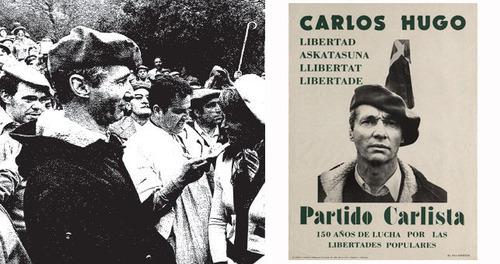
Mas por cima de todo, mola a sua estética.
E sem lugar a dúvidas o elemento mais rechamante dessa estética, a icona carlista por antonomásia, é a boina vermelha.

A que mola a boina vermelha? Pois claro que mola. Há que ser um TRISTE para que nom che mole a boina vermelha!!!
Comprenderedes logo a minha absoluta ledícia e fascinaçom quando lendo o livro em questom cheguei a esta frase:
“Es tradición que fue en Galicia donde comenzó a utilizarse la boina roja, que quedaría como distintivo del carlismo”.
O professor Barreiro (eu chamo-lhe assim porque um ano estivem matriculado numha matéria que impartia na Faculdade de História da USC. Matéria à que nunca assistim mas isso é outra cousa) nom tira esta afirmaçom da manga senom que, como docto historiador que é, remite-nos a umha fonte autorizada. Neste caso a fonte é Melchor Ferrer, escritor e coordenador da monumental “História del Tradicionalismo Español”. Um “modesto” trabalho editado em 30 volumes.
Mas a minha surpresa nom rematou ai. Nom se tratava só de que a boina vermelha tivesse aparecido entre as partidas carlistas que actuavam na Galiza, senom que a orige mesmo podia precisar-se até o ponto de identificar o autor de tam feliz iniciativa. Autora neste caso, como podedes comprovar:
“Es muy posible que el distintivo de la boina roja se deba a la condesa de Gimonde de quien se sabe que en su pazo tenía un taller de costura dedicado a los carlistas y a ella le atribuyen la confección de varios símbolos. Cayetano Jordán, pintor, confiesa haber pintado escudos en telas para la condesa”.
Informaçom que Barreiro tira do processo penal aberto contra o tal Cayetano Jordán em 1839 do que se conserva a documentaçom no Arquivo Histórico da USC.
Neste momento a minha sensaçom de WTF era absoluta. Nom só era possível que a boina carlista tivesse nascido na Galiza, senom que ademais conheciamos quem fora a possível autora intelectual. E menuda autora! Nem mais, nem menos que Dona Jacoba Cisneros de Puga, Condesa de Gimonde, da que podedes fazer-vos ideia do PERSONAJAÇO que era lendo-vos esta entrada da wikipedia. http://es.wikipedia.org/wiki/Condesa_de_Gimonde
Mas o meu estupor ainda nom rematava ai.
Nesse parágrafo, no que se falava da possível atribuçom do invento da boina a Dna. Jacoba, indicava-se que o complemento de vestiário mais chic da história política espahola teria-se elaborado no seu paço. O problema é que a senhora tinha vários paços!!!
O mais conhecido e importante é o paço rural que os condes de Gimonde tinham em Vedra, ainda existente, mas também contavam com um paço no centro de Santiago. Paço urbano situado na capital do país que aliás também era a capital do carlismo galego, nom por acaso, já que os Arcebispos e o Cabido Catedralício eram carlistas raídos.
E onde estava esse paço urbano??? Pois no mesmo solar que ocupa actualmente o Auditório Nova Caixa Galicia, esse prédio que os picheleiros de bem ainda conhecemos como “Grandes Almacenes El Pilar”, na Rua do Preguntoiro nº23. http://www.santiagoturismo.com/programadores-culturais/auditorio-novacaixagalicia
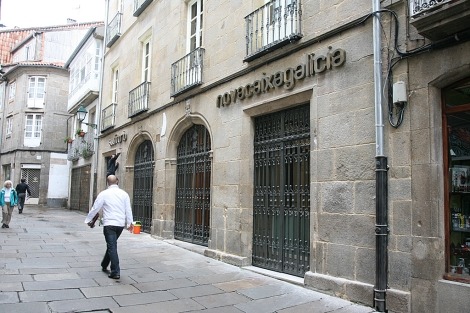
Resumindo. Nom se trata já de que a boina carlista seja umha criaçom galega, o que em si mesmo mola muitíssimo, senom que é bastante possível de que tenha a sua orige no mesmo espazo que ocupa umha das infraestruturas culturais mais infrautilizadas de Santiago (o que é todo um mérito tendo em conta que estamos a falar do concelho onde está a Cidade da Cultura). Espazo cultural que tivo um dos seus maiores momentos de afluência de público quando acolheu o espetáculo “Vaya par de gémelos”, protagonizado polos IMENSOS Bertim Osborne e Arévalo.

Assim fechamos esta entrada concluindo que neste pequeno recanto da nossa cidade, na Rua do Preguntoiro, há um espaço no que confluem o maior símbolo estético do carlismo, a expressom artística de Bertín e Arévalo e que na actualidade é propriedade da corporaçom bancária venezuelana que tem por mascota a BANESKIN.
QUE MARAVILHOSA É A NOSSA HISTÓRIA!!!!!
SnobTACOS e TOM COLLINS. Joder. :_)
Aviso: No confundir este sitio con la Cantina La Mascota. Ese es otro sitio. Ciudad de México es una ciudad loca, es capaz de tener dos locales con el mismo nombre (y más), para confundir aún más a la gente. No quiero decir que una cantina sea mejor que la otra, pero yo voy a hablar de la más pequeñita.
 In 1981, Antonio Tejero and his buddies in Guardia Civil staged the infamous coup d’état attempt which became known as the “23-F” coup, itself the climax of a time of great instability in the country wherein the economic crisis, violence by the ETA separatists, and Prime Minster Aldofo Suarez stepping down shortly after 23-F meant that everyone’s personal future was completely up in the air. It was a time of great turmoil as the country was making its transition to democracy, and everyone — from politicians to a rattled youth culture — was feeling the effects.
In 1981, Antonio Tejero and his buddies in Guardia Civil staged the infamous coup d’état attempt which became known as the “23-F” coup, itself the climax of a time of great instability in the country wherein the economic crisis, violence by the ETA separatists, and Prime Minster Aldofo Suarez stepping down shortly after 23-F meant that everyone’s personal future was completely up in the air. It was a time of great turmoil as the country was making its transition to democracy, and everyone — from politicians to a rattled youth culture — was feeling the effects.
Some of these younger people of this era wound up channeling an entire nation’s worth of aggression and disillusionment into music, and given that 1979 was the year that both Joy Division…
320 kbps | 362 MB | UL | MC1+MC2 ** FLAC
…and the Cure released their debut albums, minor keys and themes of alienation resonated strongly with kids still trying to figure out what they wanted to get out of their culture and their heritage. Young songwriters like Eduardo Benavente and Servando Carballar Heymann wound up gathering the sounds of their influences and infusing them with a style and perspective all uniquely their own. Although a majority of the music that came out of this unique post-punk scene was released independently, the DIY nature of the bands that connected with much grander, darker musical themes, soon lead to an entire movement in and of itself.
So many of these rare, fetishized cult-bands have never really been seen outside of their homeland, which is why Sombras: Spanish Post-Punk & Dark Pop 1981-1986 is such an absolutely fascinating document in and of itself. Across two discs, this Munster Records compilation doesn’t spend as much time simply throwing thematically-similar tracks together so much as it tries to construct a narrative about the scene and the effect it had on the population (plus, the historically-minded liner notes are printed in both English & Spanish to boot).
As such, casual observers won’t notice a lot of surprises with a good majority of the material here, as a great deal of these bands took their cues from artists like Bauhaus and the Birthday Party rather explicitly, the occasional act actually forgoing any actual identity of their own as they were too busy trying to be known as the Spanish Joy Division (see: Los Coyotes with their gloomy entry, “La Estacion Fantasma”). Some material is very much guitar-based (like Derribos Arias with their Robert Smith-aping “Virgenes Sangrantes” or Alaska Y Los Pegamoides’ own “El Jardin”), some of it given a healthy amount of moody analogue synths (like “Sombras en La Alcoba” by Claustrofobia’s, a group who later went on to collaborate with Robert Wyatt).
Many of the songs borrow production tropes that were popular at the time (get ready for a lot of thin drum machines and very reedy drumming during the times a drum machine couldn’t be found), and almost every guitar track contains a healthy amount of studio reverb, but even as these elements immediately date the songs, it also gives them a unique charm as well, as a great majority of these songs put their idols at the forefront of their sound, and playing Ultimo Sueno’s rather groovy “No Debiste Asustarme” for a stranger would make them genuinely wonder if it’s a Spanish-language B-side from Echo & the Bunnymen or what.
Yet, a double-disc set of songs circling around the same tropes would be boring even if looked at purely as a historical document, which is in part why some of Sombras‘s most memorable moments actually come from the selections that divert from the tired-and-true black eyeliner formula. V2 Berlin, for example, give the compilation a nice energy boost with their unabashed Ramones worship (and, rather notably, the entry about them on the liner notes features almost zero detail on their origins or their story, as the group faded away just as quickly as they arrived), and Qloaca Letal’s “Nunca Siempre” makes for a very tame punk entry with its unadorned pocket distortion, but features enough wild vocals to give it that right amount of edge and personality to make it a keeper, threatening to run off the rails of sanity at every given moment. Best of all, however, might be the bright-eyed but goth-affected guitar pop of Furnish Time’s “Juego de la Lluvia”, an upbeat encapsulation of not only what this compilation is all about, but also what the era represented as a whole, that wry bit of optimism shining in between its obvious post-punk connections.
Oh sure, there are some tracks that lean towards the more generic end of the dark pop spectrum (Luenes De Hierro’s goth-by-numers “Ellos”), and of the 42 tracks rounded up here, very few feature turns by female vocalists (fortunately, Seres Vacios’ “Recuerda” is one of the compilation’s highlights, flirting with a chorus that almost borders on optimism), but even with such judicial nit-picking discovering a dark synth classic like Aviador Dro’s phenomenal synth-rocker “La Zona Fantasma” makes the entire compilation worthwhile, as too many of these songs would otherwise have been lost to time, collecting dust in attics and obscure record stores far off from La Grand Vie. The fact that they’ve been recovered is alone a fact worth celebrating; the fact that Sombras features as much great music as it does is what makes it one of the most fascinating compilations you’ll hear all year.
Disc 1
1 Yo No – Paralisis Permanente (3:41)
2 El Jardín – Alaska y los Pegamoides (3:34)
3 Voces En La Jungla – Los Monaguillosh (4:34)
4 Serás La Más Guapa – Neon Provos (3:05)
5 El Modelo De Pickman – Alphaville (5:17)
6 Vírgenes Sangrantes – Derribos Arias (4:57)
7 Sombras En La Alcoba – Claustrofobia (2:58)
8 No Debiste Asustarme – El Ultimo Sueño (3:32)
9 El Signo De La Cruz – Decima Victima (2:19)
10 Principio Y Fin – Agrimensor K (3:50)
11 Sangre Y Arena – Ultratruita (3:07)
12 El Frío En Mis Manos – Camara (4:43)
13 Ella Se Hizo Monja – Beirut, La Noche (3:18)
14 Asfixia – Donación Agnelli (3:59)
15 Recuerda – Seres Vacios (4:53)
16 Olor a Carne Quemada – Gabinete Caligari (3:39)
17 La Estacion Fantasma – Los Coyotes (3:54)
18 La Oración – Desechables (3:43)
19 Todo Pensado (Para No Durar) – La Fundacion (3:09)
20 Sangre De Ángel – Los Iniciados (2:22)
21 Nichos – Lavabos Iturriaga (2:35)
22 Paranoia – Flácidos Lunes (2:05)
Disc 2
1 La Zona Fantasma – El Aviador Dro Y Sus Obreros Especializados (4:02)
2 Ellos – Lunes De Hierro (4:27)
3 Salón Xanadú – Jugos De Otros (4:33)
4 Seres Inertes – Cadena Perpetua (4:05)
5 Nunca, Siempre – Qloaqa Letal (2:14)
6 Humo – New Buildings (3:47)
7 Algo Está Pasando – V2 Berlín (4:01)
8 Escrito En Los Cielos – Dios (4:35)
9 Ten Compasión De Mí – Nueva Religión (2:40)
10 Aullándote – Matrona Impúdica (4:19)
11 El Sótano – Ceremonia (4:40)
12 Lágrimas – Ana Curra (3:41)
13 Azul – Polansky (3:46)
14 Te Mataré – Quebrada (3:09)
15 Lamentos De Un Vampiro – Angel Y Las Güais (1:48)
16 El Eco De Las Sombras – Pasajeros (3:48)
17 Juegos De La Lluvia – Furnish Time (3:10)
18 Tras El Fuego – Inhibidos Quizás? (3:28)
19 La Tierra Feliz – Carmina Burana (8:14)
20 Ellos – Satí De Crem (2:42)
SnobEse centro social de Sar, que nin mentan na noticia, está ocupado, ou poñen a foto por GHODER?